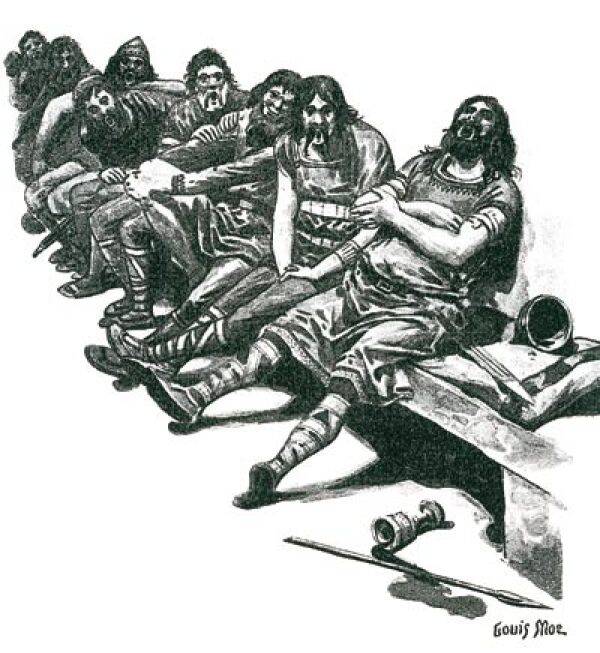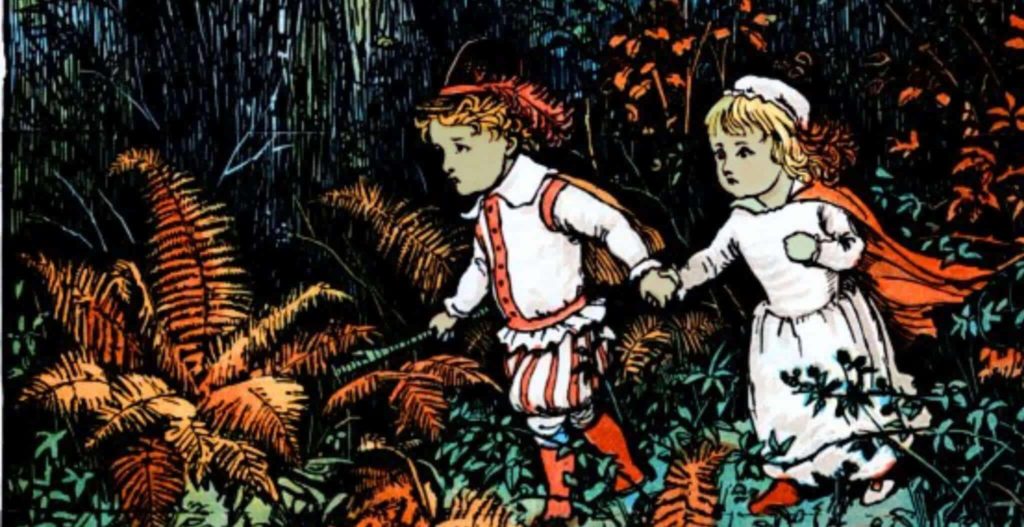When we think of Vikings you might get an image of a fierce warrior running at you with a huge battle ax and screaming at the top of his lungs. Vikings were known for their warrior culture and fierce fighting styles.
Like many other military units, the Vikings had an elite group of warriors that were more skilled than the regular troops. Viking Berserkers were Norse warriors known for their wild, frenzied fighting style and for striking terror into their enemies.
Their unpredictable and intense behavior set them apart from the regular Viking warriors, and their legendary ferocity made them a powerful force on the battlefield. In this article, we’ll explore the origins, culture, and legacy of the Berserkers, examining their impact on Viking society and their lasting influence on popular culture today.

Origins of the Viking Berserkers
Viking Berserkers can be traced back to early Norse literature and traditions. The term “berserker” comes from the Old Norse word “berserkr,” which could mean “bear shirt” or “bare shirt.” Either way, we get an idea of a warrior who either fought bare chested or wore animal skins.
The depiction of Berserkers in early Norse literature, particularly in the sagas and skaldic poetry, alludes to their extraordinary strength and courage.
The Icelandic sagas, such as the “Saga of the Ynglings” and the “Saga of Hrólf Kraki,” describe Berserkers as royal bodyguards or shock troops who were unleashed during critical moments in battle to change the tide of the war.
Elite Warriors Across Cultures
The concept of elite warriors imbued with bloodlust isn’t unique to Viking culture. This phenomenon can be seen across various societies and eras:
In ancient Greek mythology, there were the Myrmidons, legendary soldiers led by Achilles during the Trojan War, whose fearsome reputation made them seem almost invincible.
Similarly, in ancient India, the Kshatriya warrior caste, particularly during the Vedic period, was known for its ferocity and dedication to martial prowess.
These warriors often entered a state of heightened battle frenzy, driven by a sense of duty and a desire to achieve honor through combat. The ancient Sanskrit texts describe these warriors as being filled with “Veer Rasa,” or the essence of bravery.
In Celtic culture, the Fianna were elite warrior bands who fought for kings and defended territories. The ancient Irish epic, “Táin Bó Cúailnge,” describes the hero entering a battle frenzy known as “ríastrad,” during which he became an unrecognizable, raging force, tearing through enemies with uncontrollable fury.
Indo-European warrior traditions often included young men undergoing initiation rites, after which they would form bands known as “Koryos” in ancient Greek. These bands engaged in raiding and warfare, often adopting animalistic personas and fighting with berserk-like intensity.
In Japanese culture, the Samurai were known for their fierce loyalty and willingness to fight to the death. The concept of “kenshi” or “swordsman” embodies the disciplined yet intense nature of these warriors, who often entered a focused state of heightened awareness and combat readiness.
Culture and Characteristics
Like other elite warriors from other cultures, the most defining aspect of the Berserkers was the “Berserkergang”, a state of intense rage or bloodlust that they entered before combat. During this trance-like state, Berserkers were said to be empowered with superhuman strength.
The psychological and physical state of the Berserkers during this ritual has been the subject of much speculation. Some believe that the Berserkergang was the result of hallucinogenic mushrooms, while others suggest it was an intense meditative state. Whatever it was, the Berserkers’ behavior during battle was marked by a frenzied and uncontrollable aggression.
Berserkers were both feared and respected in Viking society. They often served as shock troops or personal bodyguards for kings. However, their unpredictable behavior also made them dangerous and difficult to control.
Religious and Mythological Context
The Viking Berserkers held a significant place in Norse mythology and religious practices. The Berserkers were closely associated with Odin, who was the patron of elite warriors and those who sought “Berserkergang” in battle.
The Berserkers’ trance-like state, which rendered them nearly invulnerable and gave them superhuman strength, was believed to be a manifestation of Odin’s power.
Odin is often portrayed as a seeker of wisdom, famously sacrificing his eye to gain knowledge, and on the other hand, he is a fierce warrior who rides into battle atop his eight-legged horse, Sleipnir.
One of Odin’s powers was to inspire warriors through divine possession. This state of possession, known as “óðr,” was characterized by a combination of rage, inspiration, and divine power.
Not to be confused with Berserkergang, “óðr” was seen as a form of divine madness or ecstasy that elevated the warriors’ combat abilities and allowed them to fight without fear or hesitation.
Shapeshifting and Animal Totems
Berserkers were often depicted as shapeshifters in Norse mythology. They were believed to be able to transform into animals, particularly bears or wolves. This connection to animal symbols shows how connected the Viking culture was to nature and spirituality.
The bear and the wolf were seen as powerful animal allies, and Berserkers were believed to take on these animals’ characteristics in battle. The bear was seen as a symbol of strength and protection, while the wolf represented cunning and ferocity.
The idea of warriors adopting animalistic traits or transforming into animals is a common motif in many other cultures around the world.
Berserkers in Norse Mythology
Berserkers appear in several Norse myths and legends, often as formidable warriors or protectors. In the “Saga of the Ynglings,” for example, Berserkers are described as Odin’s warriors, who went into battle without armor and fought with the strength of bears or bulls. This depiction aligns with the idea of Berserkers as Odin’s chosen warriors, embodying his divine power in battle.
In other stories, Berserkers are depicted as royal bodyguards or elite warriors who protect kings and chieftains. Their loyalty and ferocity made them valuable allies, but their uncontrollable rage also made them dangerous and unpredictable. This duality highlights the complex nature of the Berserkers, who were both revered and feared in Norse society.
Symbolism and Spiritual Significance
The Berserkers’ connection to Odin and animal totems highlights their spiritual significance in Norse culture. They were seen as warriors who could channel divine power and embody the spirit of nature, aligning with the broader Norse belief in the interconnectedness of the divine and the natural world.
The Berserkers’ trance-like state and shapeshifting abilities also align with shamanic traditions, where warriors or shamans could enter altered states of consciousness to gain power or commune with spirits.
Historical Accounts and Interpretations
How historians know so much about the Berserkers comes mostly from their written history. Even though they often blend fact and fiction, these sources are a valuable treasure trove for getting an understanding of the legacy and cultural significance of these Norse warriors.
Norse Sagas
The Norse sagas offer some of the most detailed written accounts of Berserkers, blending historical events with elements of myth and legend. For example, in the “Saga of the Ynglings,” the Berserkers are portrayed as royal guards who fought in an uncontrollable rage.
Other sagas like the “Saga of Hrólf Kraki” describe them as formidable warriors who could change the course of battles with their ferocity and strength. However, the accuracy of these sagas should be taken with a grain of salt as they were often told orally and not written down until long after the events supposedly happened.
Skaldic Poetry
Skaldic poetry is poetry that was composed by Norse poets called skalds. These Viking poems were composed in honor of kings and warriors, praising their courage and achievements in battle.
The poems continue the theme of Berserkers as elite warriors who struck fear into their enemies. While not true historic accounts, skaldic poems offer a glimpse at how Berserkers were viewed in Norse society.
Runic Inscriptions
Norse runes were characters used in writing systems known as runic alphabets. Runes typically commemorate the lives of notable individuals.
While these inscriptions provide less detailed narratives compared to the sagas or skaldic poetry, they sometimes mention Berserkers or warrior groups by name, giving historians a glimpse into their historical existence.
Legacy and Influence
Viking Berserkers were a fascinating and complex aspect of Norse history. Their origins, culture, and legacy offer a glimpse into the warrior traditions and beliefs of the Viking Age. Although these legends of immortal men may be an invention of fantasy and myth, one things is for sure:
The legacy of the Berserker has been immortalized in Western culture. Their stories continue to captivate the modern imagination. Whether in books, movies, or the language we use today.

